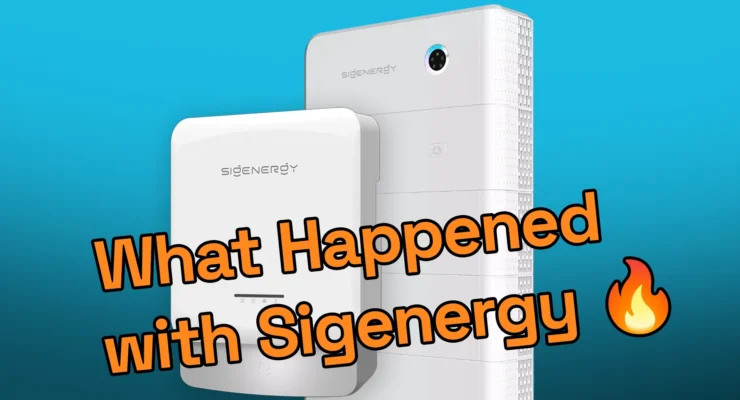
Sigenergy Battery Issue Explained: What Really Happened and Why the Fix Makes the Industry Safer
Something big just happened in Australia’s battery industry — and you deserve the facts, not the drama.
Over the past few weeks, a small number of single-phase Sigenergy battery systems have experienced heat, sparking or melting around the AC plug area. As expected, the news spread fast — and parts of the industry wasted no time using it as a marketing weapon. But this isn’t a moment for point-scoring. It’s a moment for clarity, learning and transparency.
So let’s cut the noise and break down exactly what happened, why it occurred, and how Sigenergy has responded.
What Actually Happened With the Sigenergy Fault?
A limited number of single-phase Sigenergy inverters experienced overheating at the AC connector. In some cases, installers reported visible sparking, melting or scorching around the plug. Importantly:
- The issue was limited to the AC plug area
- The event did NOT spread into the battery
- The internal fire-suppression materials and protection layers worked as designed
Now, why did it happen?
Sigenergy’s engineers have assessed affected sites and concluded that the failed plugs were not installed as per the installation instructions. This includes issues such as:
- Incorrect cable size
- Poor crimps
- Bends or terminations outside spec
Some installers, however, argue that the original connector design could have been simpler, and that some specified flex materials were difficult to source. In some cases, orange cabling was used as a workaround — potentially contributing to the failures.
As with many engineering issues, the truth likely sits between the two positions:
- A connector design that could be improved + installation practices that weren’t always perfect.
But whichever way you lean, the outcome matters more than the argument.
The VPP Factor: Why Peak Export Loads Matter
There’s another important technical layer here: Virtual Power Plant (VPP) participation.
When hundreds or thousands of batteries discharge in the evening peak — around 6 pm — export loads spike. We’ve seen this ourselves: a 14kW system in our office pushed full export for several minutes and heated the inverter until it quietly throttled itself down.
Combine that situation with:
- A heavily loaded AC cable
- A connector design that was due for improvement
- Installation variances
… and you have the classic “air-crash investigation” scenario. No single factor caused the issue. But combined, they did.
Still — and this is critical — the event remained contained. The fault did not migrate into the battery, and the safety systems performed exactly as designed.
If anything, this was a real-world demonstration of Sigenergy’s internal safety architecture working under stress.
Sigenergy’s Response Has Been Fast, Decisive and Transparent
This situation could have gone one of two ways. Sigenergy chose the responsible way — and their response has been impressive.
Here’s what they’ve done:
- Redesigned the AC Connector
A simpler, more robust ODU-style plug (the same used in their three-phase units) is now standard.
- Firmware-Level Safeguards
Sigenergy pushed a system update that:
- Monitors the AC connection
- Automatically limits export power if it detects conditions that could overheat an incorrectly installed plug
- Has already reached every online 8/10/12kW single-phase inverter
- National Engineering Support
Sigenergy deployed engineers across Australia to assist installers, investigate failures and ensure replacements happen quickly.
- Proactive Replacement Program
Sigenergy is voluntarily replacing affected units — even though this is NOT a regulator-mandated recall. They’re covering the full replacement cost and providing a $500 installer subsidy per unit.
- Additional Warranty
Every replacement inverter receives an extra 2-year warranty.
- Full Regulatory Cooperation
Sigenergy has been working directly with electrical regulators throughout the process, providing site evidence and ensuring compliance at every step.
This is what industry leadership looks like.
The Industry Media Reaction: Why Context Matters
Some online coverage presented the issue with dramatic framing, implying secrecy while ignoring the regulatory reality that manufacturers cannot comment publicly until safety bodies approve disclosures.
For the industry, while it makes such communicators look like they are looking after the industry, maybe one also needs to look at the potential motive, and then there is the risk of fear and confusion and a potential spike in “Pink Batts 2.0” mainstream headlines waiting to happen. That’s bad for the whole industry. Let facts win over emotions, and the facts are far less sensational:
- Yes, there was an installation-related connector issue
- Yes, the design is being upgraded
- No, the battery was never at risk
- Yes, Sigenergy is replacing affected units at its own cost
- Yes, the industry is learning from this
That’s what matters.
Did Sigenergy “Blame Installers”? Not Exactly — And Here’s Why It Matters
Some installers feel targeted by the early findings, but consider the alternative: If this had been classified as a battery defect, the entire CEC approval system could have been thrown into review.
That would affect every approved battery in Australia — not just Sigenergy.
By identifying installation variation as a contributing factor, the industry avoids:
- Insurance chaos
- Regulatory shutdowns
- Broad product suspensions
- A consumer confidence crisis
And remember: Sigenergy has already upgraded the connector design anyway. That’s not blame — that’s progress.
So Should Australians Be Worried?
No. The issue was contained, the fix is underway, and the new connector design is already rolling out. My own Sigenergy system is operating normally, in a safe location, and I’m not concerned.
This is how a mature industry handles a fault:
- Identify contributing factors
- Engineer the fix
- Replace affected units
- Improve communication
- Move forward stronger
Don’t kick people when they’re down. Help them improve.
That’s how the solar and battery sector evolves — and this Sigenergy situation is exactly that: learning in action.




